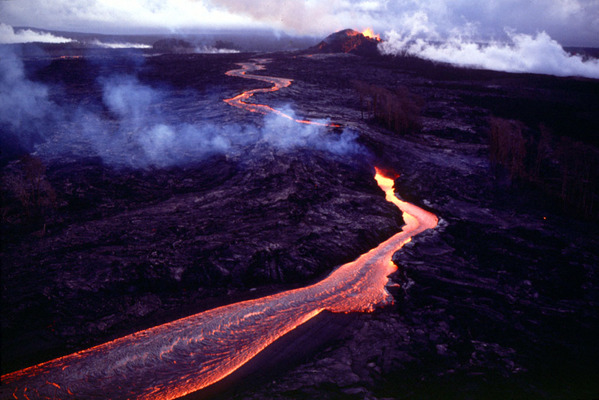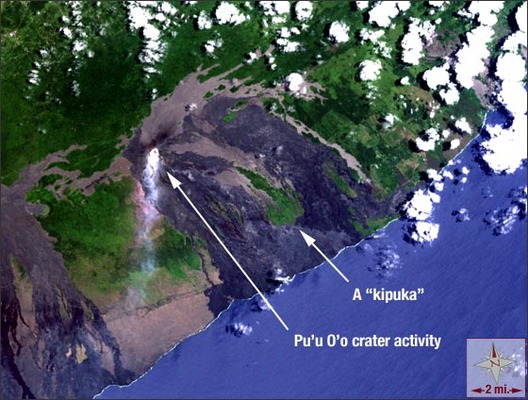
by Carolyn Gramling Thursday, January 5, 2012

Aerial view of channelized lava flow from Pu'u O'o in 1983. Photo is by J.D. Griggs, courtesy of U.S. Geological Survey

The location of Kilauea's Pu'u O'o crater activity in 2001. NASA Landsat
SAN FRANCISCO — While drilling deep into Earth, geothermal engineers struck geological gold, opening a never-before-seen window into a classic geologic process: how basalt magma becomes granite. The find, they announced at the annual meeting of the American Geophysical Union on Tuesday, could amount to the first magma observatory on Earth.
Ormat Technologies, a geothermal company, has been producing electrical power on Hawaii’s Big Island since 1989. In 2005, the company decided to drill a deep injection well at its site, Puna, located on the eastern part of the island. But about 2.5 kilometers down, the drill suddenly dropped straight through solid rock into molten magma.
That they might drill into magma isn’t particularly surprising, said William Teplow, a consulting geologist for Ormat, at a press conference Tuesday. The Big Island is dominated by active volcanoes, including Kilauea, which has been actively erupting along its eastern rift zone for more than 25 years. “If we had hit molten basalt it would not be a big surprise,” Teplow said. But the magma they encountered wasn’t basalt.
During drilling, the team was keeping close watch over these wells, located in one of the highest-temperature geothermal fields in the world, with production temperatures hovering around 350 degrees Celsius. Once exposed to the air, the topmost magma in the well cooled rapidly, forming a skin of glass over the still-molten magma below. When it hit the magma, the team pulled up and then sank the drill bit once more, this time drilling into the newly formed glass and retrieving the cuttings.
“We knew that they were highly anomalous as soon as we drilled them,” Teplow said. The glass cuttings that came back to the surface from the well were clear and colorless — but basalt, when it forms glass, is an inky black. “It was very striking and we knew immediately that we had some anomalous body of rock.”
Teplow brought the cuttings to geologist Bruce Marsh of Johns Hopkins University in Baltimore, Md. Marsh analyzed their chemical composition: They turned out to be dacite —a type of volcanic rock with intermediate chemical composition between basalt and granite.
“I was elated,” Marsh said at the meeting. The well, he said, is a window into a classic geologic process: the process by which a basalt magma chemically differentiates into granite, the type of rock that makes up much of the continents (as opposed to the seafloor). Differentiation is a gradual process: as some of the minerals in the melt cool and solidify, some remain molten longer. As a result, the melt that’s left behind becomes more and more chemically different from the original magma.
Although the differentiation of basaltic crust into granitic crust is a fundamental process in geology, making the continents chemically distinct from the ocean floor, geologists never see this process in action. Instead, they have to study it in a “post-mortem” fashion, Marsh said. “We try to piece history back together from systems that were once alive.” Seeing this process in its “natural habitat,” on the other hand, is like “Jurassic Park” — but for geologists, he said.
The find could be a boon to geothermal energy extraction, Teplow noted. Around the world, scientists and engineers are looking at sites as much as five kilometers deep inside Earth for hot-enough rock to produce geothermal energy, but at the Puna site, superhot rock — 1050 degrees Celsius — is only 2.5 kilometers deep, he said. “All the facilities are in place for studying this mass of hot rock.”
There’s a lot that’s not yet understood about this find and the geothermal field, Marsh noted, including the size and shape of the dacite magma body, as well as its age. “This is an unprecedented discovery,” he said. “It’s just the tip of the iceberg.”
© 2008-2021. All rights reserved. Any copying, redistribution or retransmission of any of the contents of this service without the expressed written permission of the American Geosciences Institute is expressly prohibited. Click here for all copyright requests.